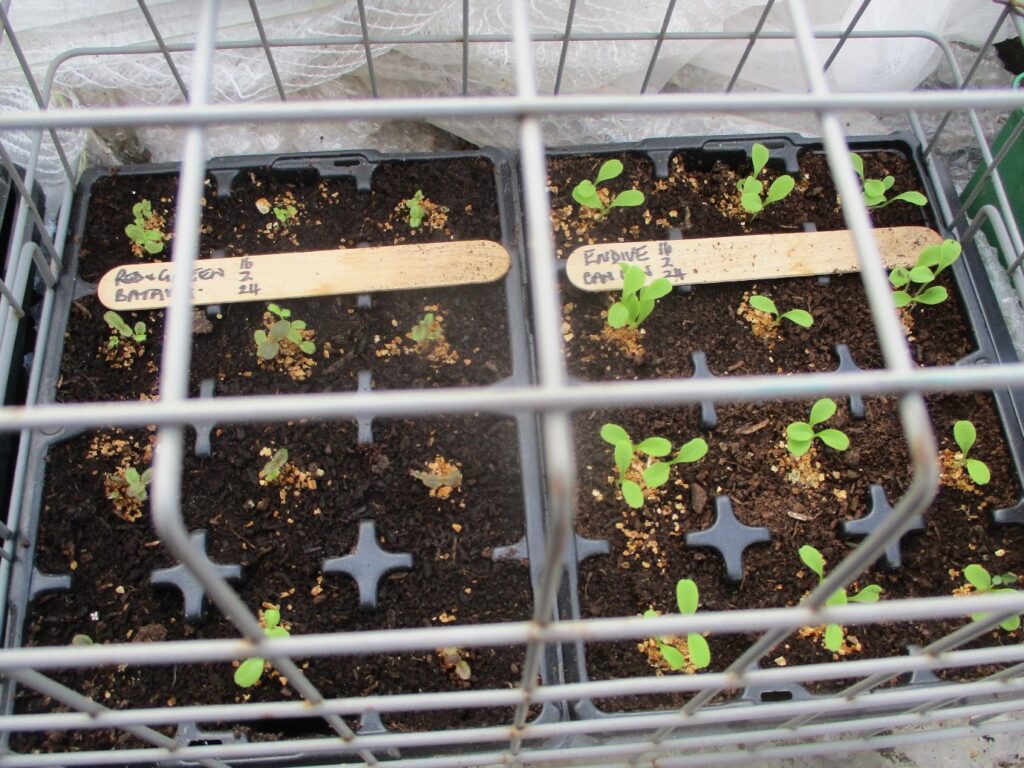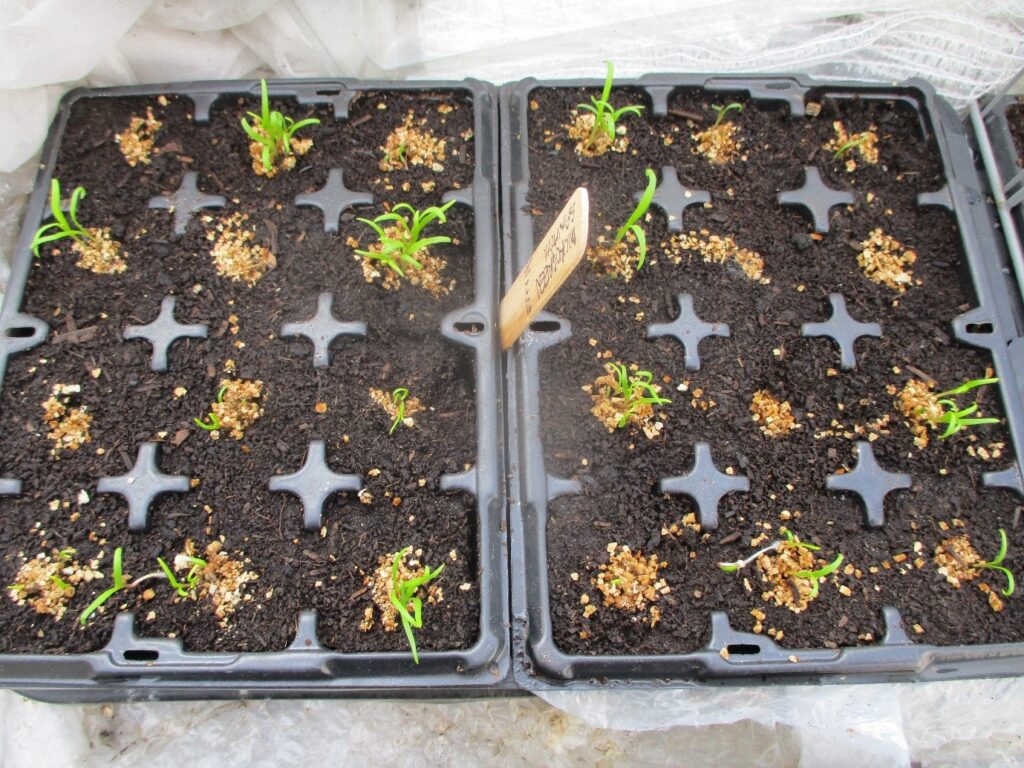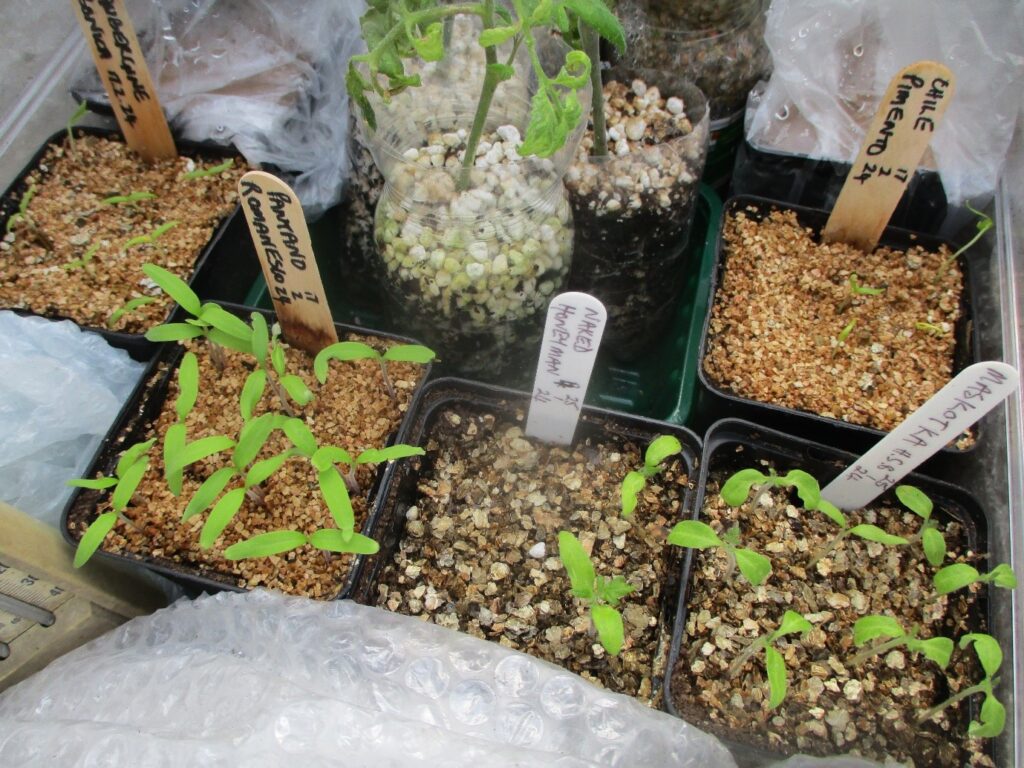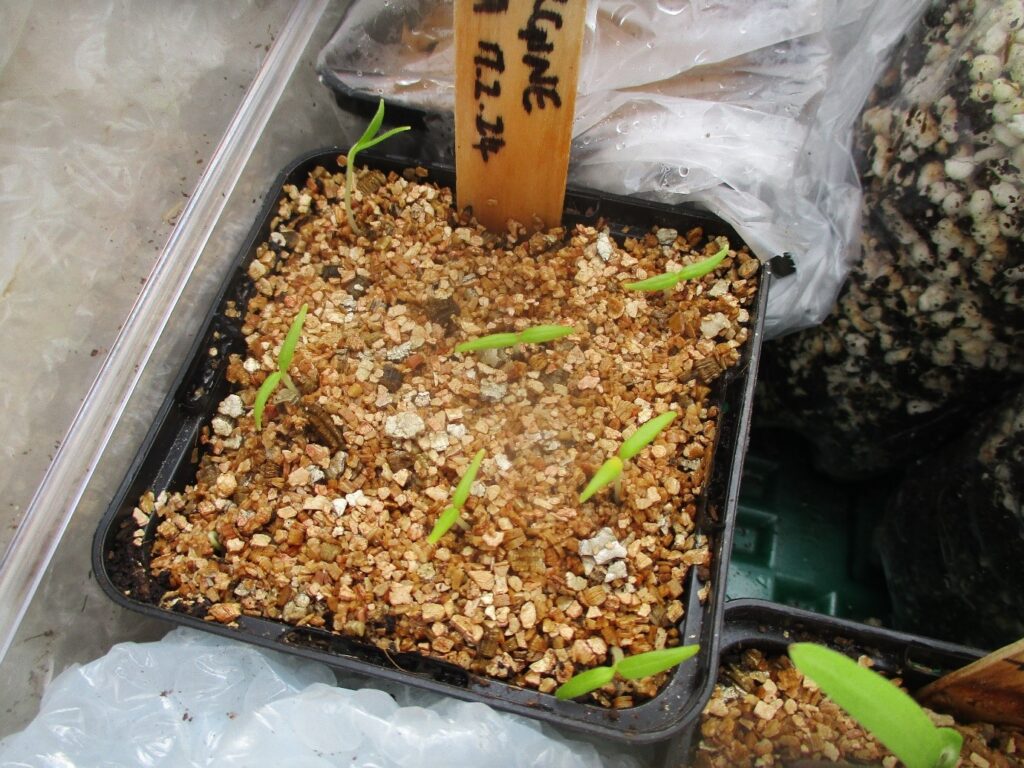REMEMBER MY ADVICE – IF YOU’RE SHORT OF TIME, JUST GET THE SEEDS SOWN! YOU CAN CATCH UP WITH EVERYTHING ELSE LATER, BUT IF YOU DELAY, THEN IT MAY BE TOO LATE FOR SOME CROPS OR THEY MAY BE DISAPPOINTING….. TIME WAITS FOR NO MAN! (Or woman!)
Funny how we spend so much of our time wishing away winter – but then hoping everything would happen just a bit more slowly in spring. Gardeners are never happy!


While we’re sowing food for ourselves – it’s more important than ever to sow some nectar and pollen producing plants for pollinators too!
First – Some General Advice for March Seed Sowing:
There are quite a lot of things you could sow now in pots or modules either in the house on a windowsill, or in a propagator in a greenhouse or polytunnel, for planting out later in a tunnel, greenhouse or sheltered cold frame. You can still do most of your seed sowing in modules inside in comfort on the kitchen table though – there’s really no need to go outside in the freezing cold unless you’re a masochist!
Most seeds are happy to germinate at normal house room temperature and as most take a week or so to appear anyway – you can sow some things inside the house and then put them out into good light in a greenhouse or frame as soon as the seedlings are showing. Seedlings like lettuce, summer (annual, not beet) spinach and hardier salad plants will be fine then, with just some protection from frost at night with a couple of layers of fleece.
It is light that mostly governs healthy plant development – so you can save money and valuable energy by not wasting any heat needed for another couple of weeks yet, no matter how keen you are. In fact, pushing plants by giving too much warmth without enough light doesn’t make them any earlier, and can be detrimental to plant health, causing ‘etiolated’ seedlings – meaning they stretch towards the light. This often happens with windowsill-raised seedlings, and they can be much more prone to pests and diseases as a result
From over 40 years’ experience, I’ve found that using a good organic peat-free seed compost is by far the best and most reliable choice for sowing everything – not just from a plant health point of view, but also for environmental reasons. Any extra expense is well worth it in terms of valuable seeds and seedlings not being lost to the diseases or pests which peat composts including synthetic, fossil fuel-derived chemicals seem to encourage.
After sowing at no more than twice the depth of the seed – cover the seeds with vermiculite, which promotes good air circulation and drainage around the neck of the seedlings, then water gently with a small, fine rose watering can or a hand sprayer. Then cover the seed trays or modules with clean, recycled polythene bags and put them somewhere in your house at average room temperature – not on a south facing windowsill, where they can literally ‘cook’! Most seedlings will be up within a few days or a week. I find seeds like lettuce or summer spinach take about 3 days at normal cool room temperature – they don’t need a lot of warmth. Tomato seeds generally take around 5 days in the 70-75 deg F /or 21-24 deg C on the back of my kitchen range, if they are fresh seed. Make sure to put the trays you have sown somewhere where you will remember to check on them twice a day though, as seedlings like lettuce can become leggy very quickly if not given good light immediately they have germinated.
Speaking of light – once they have appeared, probably in a week or so for most things at this time of year, they will then need the very best light you can give them – which means either a tunnel, greenhouse or perhaps a cold frame against a south facing wall. They will also need very good air circulation – so sowing in modules either individually or in 2’s or 3’s to thin or divide later is the best option. This avoids handling vulnerable seedlings while ‘pricking out’, which may result in damage and possible ‘damping-off’.
If the weather is too cold for them to be outside, or if your windowsill is the only option, one trick I learnt many years ago, was to take off the top and one side of a cardboard or wooden box, and paint the rest of it with white paint, or cover it with foil, or those cheap plastic mirror tiles you can buy from DIY stores, to reflect any light from the window back onto the seedlings. This helps to prevent them from getting too leggy and drawn. It won’t perfectly compensate for the lack of direct top light, but it still makes a huge difference. Leggy, drawn seedlings are far more likely to suffer from diseases like ‘damping off’ as I mentioned earlier. I have never used grow-lights – I think they’re not just a waste of money but also a waste of energy – something we should all be far more conscious of now. Reducing our carbon footprint should be a priority – even though we’re growing crops which may help, even in a small way, to mitigate CO2 emissions


Remember – all the suggestions below are for things which you COULD sow now if you want to – NOT things you MUST!
What you can sow now in a heated propagator, for growing on later in a polytunnel or greenhouse:
Aubergines – (as early as possible in the month to get the best crops). Bonica F1 is the one I find crops best here – (this came top of RHS trials & was awarded an AGM about 20 years ago – I don’t bother to grow any other now as it’s by far the most reliable cultivar), alpine strawberries (Reugen a large-fruited var.), globe artichokes, (if sown early in the month, they’ll crop outside in autumn this year), dwarf French beans for cropping in pots or in tunnel beds later (choose a fast-growing, disease-resistant variety suitable for early sowing), asparagus, celery, celeriac (early in month) tomatoes (as soon as possible now for best crops – especially if you live north of the Midlands in the UK, or north of Dublin in Ireland), chilli and other peppers, physalis (Cape gooseberries). From mid-March onwards you can sow early courgettes for tunnel growing, and then at the end of the month melons and cucumbers for warm tunnel cropping. Don’t forget melons and cucumbers need to be grown on in consistently warmer conditions than tomatoes to be really successful. They grow very fast and hate to be checked (this applies to pumpkins & squashes too – so wait until next month to sow them in pots if they’re for growing outside later).


*Also sow some single-flowered tender annuals now like Tagetes, single French marigolds (Tall Citrus Mixed’ is a good variety), etc.- lots of vital beneficial insects like bees, hoverflies, butterflies and moths really love these. Remember that by growing single flowers organically you won’t just be helping to preserve pollinators and insects which are under enormous threat now – but they will also help you, by helping with your pest control and pollination.
It’s vitally important that they should be SINGLE flowered, as bees, hoverflies and other insects can’t access the nectaries of double flowers in order to feed – so those flowers are completely useless to them! They then have to fly elsewhere to find food. When their energy supplies are low, wasting time trying to get nectar from useless flowers can make the difference between life and death for many small insects including bees!
In pots or modules in the polytunnel without heat, or direct in tunnel soil as soon as you feel it’s warm enough:
(If weed seeds are germinating – then the soil is warm enough for most things which don’t need very high temperatures for germination)
Beetroot, broad beans and peas, spring and summer cabbage, calabrese/broccoli, carrots, white turnips and radishes (in the soil for an early tunnel crop), onions, chives, Welsh (perennial salad) onions, scallions, leeks, lettuces and salad mixes early in the month, kales, rocket, spinach and coloured Swiss chards etc for baby leaves, fennel and ‘soft herbs’ like borage, parsley, dill, Greek oregano, salad burnet and coriander.
Other single flowered annuals like limnanthes, convulvulus tricolour and calendula (pot marigold) can also be sown direct into the soil in polytunnel beds now.Keep an eye out for hungry mice – they love pea and bean seeds – it’s a good idea to put down a trap – but cover to avoid trapping small birds like wrens and robins.
If you have space now in the tunnel or greenhouse where you’ll be planting tomatoes in May – then you just have time to sow a green manure:
‘Caliente’ mustard (generally available now – one packet will easily sow a bed about 20ft x 4ft.) This mustard is a very useful green manure because it acts as a natural ‘biofumigant’ by releasing a plant phytochemical, in the form of a gas, called isothiocyanate. This suppresses a range of soil-borne diseases and harmful nematodes – it also encourages beneficial bacteria and soil micro-organisms, adds nutrients and really encourages worm activity. It’s particularly helpful where the soil has previously grown tomatoes. A couple of weeks before planting the tomatoes, cut it down – chopping it up as finely as possible in order to release all its beneficial compounds – and then incorporate it into the soil surface immediately – before the resulting gases escape. Then cover it with black polythene to seal the gases in. As it’s a member of the brassica (or cabbage) family – make sure that it fits into your minimum 4-course rotation even though it will only be there for a short time.
Phaceliais another fast-growing ‘soft’ green manure well-worth sowing now if you have space – this can also be dug in after just one months growth, will break down quickly and it isn’t rotation sensitive, so it can be used anywhere. Leaving one or two plants to produce their pretty scented blue flowers later on will also really attract in the beneficial insects too!
Red cloveris also useful, because being a leguminous plant, it fixes ‘free’ atmospheric nitrogen which it concentrates in nodules on it’s roots, made by beneficial microbes. This is then released for the following crop (leave a few to flower for bees – they adore them!). Studies also show that growing a legume crop between tomato plants boosts their disease-resistance, bu encouraging beneficial bacteria..
Borage also makes a good very fast-growing green manure, with a long tap root which draws up valuable minerals such as magnesium from lower down in the soil profile. It breaks down easily when dug in and encourages good worm activity, as does claytonia(or winter purslane). Both Borage and Claytonia are useful in salads and smoothies too.
What you can sow outside, if you have ground covered with cloches – or undercover now for planting outside later:
In modules under cover without heat, in a cold frame, or under cloches – or when the soil is dry enough and has warmed up later in the month – unprotected in the open (covering with fleece on frosty nights) you can sow:
Beetroot, broad beans, carrots, mangetout and early peas, parsnips, late spring and summer cabbages, red cabbage, early Brussels sprouts, cauliflowers, calabrese and summer sprouting broccoli, onions (plant onion sets in pots for an early crop), leeks, spring onions, lettuces, kohl rabi, Ragged Jack and Cavolo Nero kales for baby leaves, radishes, Swiss chard, summer spinach, white turnips, American land cress, lamb’s lettuce, salad mixes, ‘soft’ herbs like borage, parsley, dill, fennel, Greek oregano and coriander. There’s a lot of nonsense talked about germinating parsley, but it just likes to be warm and usually takes about 3 weeks to germinate at anytime of year – it always finally appears just when you think it’s not going to!
It’s also worth sowing some single, early flowering annuals in the open ground or in modules for planting out later – such as limnanthes (poached egg plant), calendula, cerinthe, convulvulus tricolor, borage, red clover and phacelia. They’ll attract beneficial insects to help with pest control, encourage bees into the garden for pollination and also look beautiful – which is very important too.
There’s still just time to plant some garlic early in the month. Only plant varieties clearly labelled as ‘suitable for spring planting’‘ now – such as ‘Christo’, Morado or Solent Wight.
Plant Jerusalem artichokes, and also early potatoes in warm, well drained soils – protecting from frost with fleece later (see veg. garden section). These will crop early enough to completely avoid blight. Alternatively – if your ground conditions aren’t suitable – you could start them off in pots now for an earlier crop which will avoid blight – I do this with all of mine now. You can also start off Yacon, Oca, Mashua and Ulluco tubers inside in pots of well-drained peat-free compost now for planting in the polytunnel or outside later – be sure to protect these carefully from frost when they start to produce shoots!
PS. Don’t forget that these are just suggestions for what you could sow now – not what you must! I found a checklist/reminder like this invaluable when I was just starting off many years ago – and I actually still do! With so much to do at this time of year it’s easy to forget something and then it can be too late!
Do you know, someone once actually complained that I gave far too much information!! So, I thought I’d make it quite clear that you don’t have to sow everything on the list! ………. You just can’t please everyone – and all the information here is free!